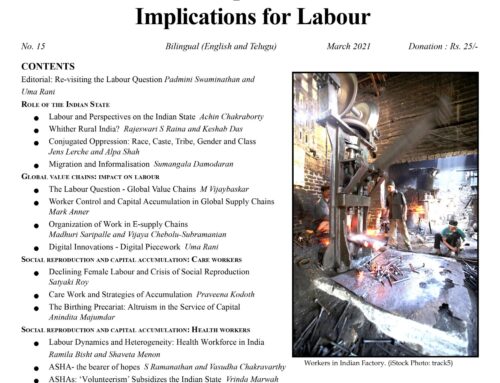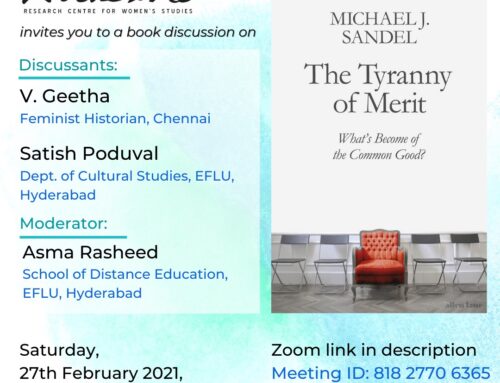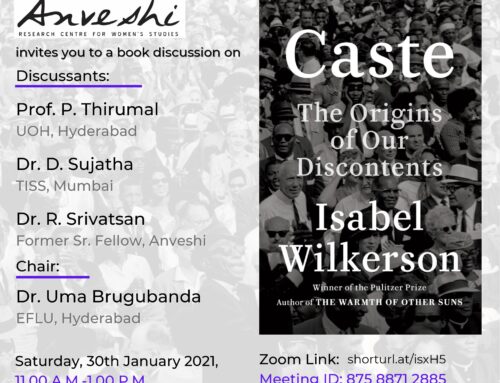The politics in the Hyderabad state had a contentious relationship with mainstream nationalist politics prior to 1948. Today, as Andhra Pradesh is at the threshold of inevitable bifurcation, it is also building and retrieving memories of Hyderabad’s past. As part of this engagement with history and memory, Anveshi, on the 21st of December 2013, organized a workshop around the evolution of Muslim politics in the Hyderabad state. The aim was to retrace the specific history of this politics between the period 1935-48 to understand the ongoing discussion on the effects of accession/integration as well as to trace the genealogy of political questions that confront us regarding minority politics today.
M.A. Moid set the tone for the workshop by tracing the roots of MIM (Majlis-e-Ittehadul Muslimeen). His presentation divided MIM’s genesis from its first phase, conceived to bring different sects together upto its role before the police action of 1948. Majlis, by also acting as political representatives of the Muslims, provides a vantage point for revisiting the community’s perceptions and apprehensions around the chaotic transition of Hyderabad. In this context, the paper discussed the disagreement between the Majlis and the Congress on the nature of political reforms; the contestation with the Arya Samaj on the nature of communities in Hyderabad, and Majlis’ strand of Hyderabad nationalism, which sought to retain, and envision an independent Hyderabad state after the emergence of India and Pakistan. What is important here though is the manner in which social negotiations and pressures have been represented to us as ‘communal’ which makes any retrieval taxing. This question is then taken up by the second part of the paper presented by A. Suneetha.
She overturns the term ‘communal’ and to instead ask “why did the Muslims believe it (Majlis) carried their interests?” This inversion enabled her to locate it in the larger context of communal politics of Indian nationalist movement and the Hindu nationalist formations such as the Arya Samaj, Hindu Mahasabha that necessitated the Hyderabad state’s Muslims also to imagine themselves as a political community. She also looked at the socio-economic upheaval and the loss of power experienced by the Muslims with the rise of a Hindu middle classes in the state that forced them to assert their identity as separate from the Muslim ruler and the aristocracy. Her argument explored the construction of the Muslim political subject in the face of shifting socio-political topography of the time.
The ensuing discussion by Susie Tharu sought to politicize the figure of the Muslim in Majlis politics or minority politics by opening up questions of representation and interpretations of history. She asserted that the Majlis’ articulation of “Muslim” away from Nizam as the Muslim ruler re-presented the Muslim as a secular political entity. She pointed out that the need for Muslims to come together under the invocation of Quran is constituted also by the historical moment as they encountered nationalist thought. The secular, modern demands put forth by the Majlis in relation to administrative reform or other political reforms are part of the manner in which minority rights can be and need to be articulated. The paper, she said, attempts to open up issues related to writing a genealogy of minority politics which is different from writing a history of minority politics. This was also evident in the kind of information and sources from which it drew such information. These insights were followed by sets of questions that opened the debate on the role of the larger national context, Hindu-Muslim ‘tension’ and questions on the nature of history and relations of the ruler with the public.
Debunking of history is a process of contemporary reflection. In the second session of the morning, Sangisetty Srinivas opened up the communist and the modern Telugu rhetoric against the Nizam and Razakaars through a revision of Telugu literature between the periods of 1935-50. Srinivas discusses the political tension that the nationalist formations had with the Nizam’s rule in that period. He then argues that the communists interpreted this tension as the struggle against the Nizam’s ‘dictatorship’, thus conflating their position with that of the nationalists. His paper problematized many ‘historical’ assumptions about Osman Ali Khan’s rule, prevalent in different historiographies of this period. The quick ascendance and pre-dominance of Andhra Telugu discourse after 1948, which did not have organic understanding of the Hyderabad state, has led to this state of affairs where the history of Hyderabad state has been written wrongly. He demonstrated that the Telugu-Urdu or Hindu-Muslim distinctions are less important in understanding the politics of this historiography than the Hyderabadi and non-Hyderabadi distinctions. Sangisetty posited the vitriolic against the Nizam with the harmonious, revolutionary movement of the Dalits within the state and their acceptance of Islam to show the biased representations that writers of the period indulged in.
The paper by thoroughly complicating the history presented by the period’s works opens up the need to review and retrieve the past through research on both Telangana and Andhra stances on Nizam rule. K. Lalita indicated in the discussion that the fictionalization of the Razakaar is also part of the way in which dominant communities are able to hold power, and to understand the state’s history, one must navigate the messy terrain of its politics. She also pointed out the rich archive Sangisetty was excavating in the form of pamphlets, little known records of speeches, essays and novels in order to arrive at a different historical perspective with respect to the period.
The panel discussion in the afternoon saw the tension that is the result of a politically eclectic grouping. Hasanuddin Ahmed, who helped publish his brother-in-law’s account of the police action period spoke of the disturbing turn that democratic ideals seem to be taking, not only in India but in other parts too. He asked the audience to think of one question “Was Hyderabad a theocratic state under the Nizam?” and provided five historical pointers why it was not. Gita Ramaswamy turned the minoritarian lens to present it as a problem of the majority. Looking at the state of Muslims and the Dalits after this period, she observed that we as majority become complicit by not allowing for the voices of the period to emerge.
The discussion also took up the questions presented in the form of rising communal tension and nationalist divisions that were a result of newer political articulations. Ziauddin Nayar focused on the Nizam’s rule and asserted that the beginnings of ‘nazarein’ (token gifts) encouraged corrupt practices allowing for Hindu forces from up north to enter Hyderabad. MIM started as a reaction against this socio-political shift. This focus on Nizam as ruler, not a ‘muslim ruler’ was a prevalent theme in the discussion. Bhangya Bhukya’s assertion that since the recognition of Khalifa and Shari’a law are integral to a Muslim state, overthrows the communal imaginings of Nizam’s rule as the Asaf Jahis never swore their loyalty to the Khalifa or Shari’a. His work on the history of communities forged a connection between the Dalit, Tribal and Muslim positions as nomadic, welcoming cultures; this also aided conversion of Dalits at the time. Discontent came from the European feudal model and the power imbalance on the question of land and caste in the state. The final discussant Inukonda Tirumali, compared the history of Hyderabad with that of partition in the northern subcontinent to claim that Deccan’s integration was a process of harmony and not violence. Tirumali’s argument was that the presence of the Nizam as the ruler of the region provided the basis for this peaceful transition.
This became central to the subsequent discussion on the definition of violence as well as the historical method. The participants rearticulated the historian’s disciplinary stance to provoke questions on how history gets written. The question of what information makes it to books and what gets left out, and the absences that it reproduces through this standardization were debated in this final discussion. The workshop in this sense indicated the need to reinvestigate the ‘historical method’ and to work towards writing a genealogy of the minority politics, rather than more inclusive retelling of the past.
Pranoo Deshraju





Leave A Comment